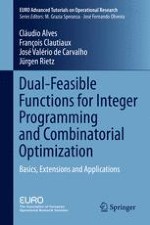2016 | Book
Dual-Feasible Functions for Integer Programming and Combinatorial Optimization
Basics, Extensions and Applications
Authors: Claudio Alves, Francois Clautiaux, José Valerio de Carvalho, Jurgen Rietz
Publisher: Springer International Publishing
Book Series : EURO Advanced Tutorials on Operational Research
